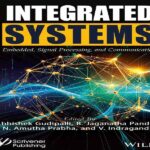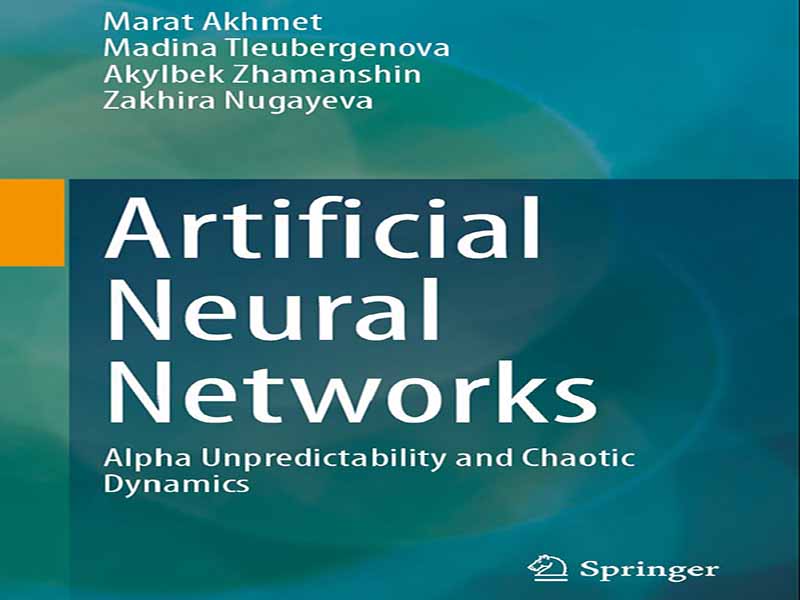- عنوان کتاب: Artificial Neural Networks – Alpha Unpredictability and Chaotic Dynamics
- نویسنده: Marat Akhmet
- حوزه: شبکه عصبی
- سال انتشار: 2025
- تعداد صفحه: 359
- زبان اصلی: انگلیسی
- نوع فایل: pdf
- حجم فایل: 19.5 مگابایت
علوم اعصاب به شدت با نظریه نوسانات مرتبط است. بسیاری از فرآیندهای فعالیت مغز و شبکه های عصبی مصنوعی در حال نوسان هستند. با توجه به حرکات نامنظم در منطقه، می توان نتیجه گرفت که مطالعه دینامیک آشوب ضروری است. در نتیجه، محققان باید مدلهایی را در نظر بگیرند که رفتارشان علاوه بر حرکات مکرر پیچیده است، مانند شبه تناوبی، تقریباً دورهای و پواسون پایدار. از لحاظ تاریخی، هرج و مرج به عنوان بازی جمعی مشاهده شده است که در آن همگرایی و واگرایی، حداقل برای زوج های همسایه باید دیده شود. در همان زمان، تحلیل غیرخطی محافظه کارانه درخواست می کند تا بر روی حرکت های مجزا متمرکز شود. هنوز هم برای تحقیقات روی فرآیندهای عصبی معتبر است. بنابراین، ما چالش حفظ روشهای سنتی معادلات دیفرانسیل را برای انجام مطالعه و کاربردهای دینامیک شبکههای عصبی نظری در شرایط تئوری آشوب مدرن داریم. فعالیت پژوهشی ما حل مشکل است. محتوای کتاب به توسعه دقیق ایدههای مربوط به هاپفیلد، کوهن-گروسبرگ، شبکههای عصبی سلولی مهاری و اینرسی اختصاص داده شده است. علاوه بر شکل پیوسته اصلی آنها، ما ساختارهای ترکیبی جدید را به عنوان مدل های تکانشی با یک استدلال ثابت تکه ای برای غنی سازی منبع پویایی پیچیده در نظر می گیریم. تابع غیر قابل پیش بینی آلفا، مفهوم جدیدی که در مقالات خود معرفی کردیم، سنگ بنای تحقیق ما است. این یک سازه نظری است اما ابزاری کاربردی است که می تواند در زمینه های مختلف علمی کاربرد داشته باشد. این تابع که مشخصه ای از توابع پایدار پواسون است، خطی از توابع محدود مکرر را تشکیل می دهد که با تعادل شروع می شود و با توابع پایدار پواسون به پایان می رسد. عود با جابجایی نامحدود یک تابع در امتداد محور واقعی، که یک مختصات آرگومان است، تعیین می شود. به عنوان مثال، اگر تابعی برای هر دنباله در حال تغییر به خود برگردد، یک تابع ثابت (تعادل) است. برای پایداری پواسون، بازگشت برای یک دنباله اتفاق می افتد، و همگرایی در زیر مجموعه های فشرده روی محور یکنواخت نیست. ما بین این دو نوع توابع تناوبی، تقریباً تناوبی و مکرر داریم. اینها فقط ساختارهای نظری نیستند، بلکه معمولاً در علم و صنعت با آنها مواجه میشوند و پیامدهای مهمی برای پویایی شبکههای عصبی و سایر سیستمهای پیچیده دارند. علیرغم پیچیدگی و ظاهر آنها در نتایج پیشرفته، مانند قضیه عود H. Poincare، توابع پایدار پواسون اصلی نمی توانند به اندازه کافی آشوب را نشان دهند. برای پرداختن به این موضوع، شرط دیگری را معرفی می کنیم، مکمل پایداری توابع، که آن را غیرقابل پیش بینی بودن آلفا می نامیم. این شرایط فقط اصلاح مفاهیم موجود نیست، بلکه یک ایده کاملاً جدید است که در تحقیقات ما بسیار مهم است زیرا توانایی ما را برای گرفتن و نمایش عناصر آشفته در پویایی سیستمهای پیچیده افزایش میدهد. این بر اساس یک دنباله اعداد حقیقی گسسته دیگر است، افزایشی و نامحدود، به طوری که واگرایی به دنبال همگرایی حرکت تا نقطه اولیه آن است. بنابراین، ما دو شرط مکمل داریم که در مقابل یکدیگر قرار دارند. این ترکیب به ما این امکان را می دهد که از دیدگاه فلسفی بگوییم که ماهیت طبیعت را در تحقیق منعکس می کنیم. اول از همه، ما در مورد فعالیت مغز فکر می کنیم، زیرا باید با روش هایی تحقیق کرد که آنچه را که به طور اجتناب ناپذیر متضاد و متناقض است برای انعکاس پویایی جهان متحد می کند. بنابراین، ما یک استدلال دیگر برای خواننده ارائه می کنیم تا نتایج ما را برای دنبال کردن آنها مفید بداند. بسته شدن یک تابع غیرقابل پیشبینی آلفا در فضای عملکردی، دامنهای برای هرج و مرج اولترا پوانکره است که در تحقیقات قبلی ما به آشوب پوانکره معروف است. تابع یک عنصر آشفته دینامیک است و رفتار پیچیده ای را ارائه می دهد. پذیرش این تابع با مشخصه های عددی به وضوح برای علوم اعصاب مفید است. این کتاب به شدت از این مزیت برای توصیف شبکههای سنتی استفاده میکند و بر ویژگیهای پویا جدید آنها تأکید میکند. برای تشویق خوانندگان، به آنها اطلاع می دهیم که اگر کسی قصد دارد در منطقه ای که ما طراحی می کنیم کار کند، داشتن درک عمیق از نظریه آشوب غیرضروری است. علاقه مندان به بحث می توانند از معادلات دیفرانسیل معمولی در سطح ابتدایی و اطلاعاتی در مورد وجود حل محدود بر محور واقعی سیستم های شبه خطی آگاه باشند. اصول اولیه مورد نیاز در بخش مقدمه ارائه شده است.
Neuroscience is strongly connected to the theory of oscillations. Many processes of brain activity and artificial neural networks are oscillating. Considering the irregular motions in the area, one can conclude that it is necessary to study chaotic dynamics. Consequently, researchers are to consider those models whose behavior is sophisticated besides recurrent motions such as quasi-periodic, almost periodic, and Poisson stable. Historically, chaos has been observed as collective play in which convergence and divergence should be seen, at least for neighbor couples. At the same time, conservative non-linear analysis requests to focus on single isolated motions. It is still valid for research on neural processes, too. Thus, we have the challenge of keeping the traditional methods of differential equations to perform the study and applications of theoretical neural network dynamics in circumstances of modern chaos theory. Our research activity is solving the problem. The book’s content is devoted to carefully developing ideas concerning Hopfield, Cohen-Grossberg, shunting inhibitory cellular, and inertial types of neural networks. Besides their original continuous form, we consider new hybrid structures as impulsive models with a piece-wise constant argument to enrich the source of sophisticated dynamics. The alpha unpredictable function, a novel concept we introduced in our papers, is the cornerstone of our research. It is a theoretical construct but a practical tool that can be applied in various scientific fields. This function, a specification of the Poisson stable ones, forms a line of recurrent bounded functions that starts with equilibriums and ends with Poisson stable ones. The recurrence is determined by unbounded shifting of a function along the real axis, which is an argument coordinate. For instance, if a function returns to itself for any shifting sequence, it is a constant function (equilibrium). For Poisson stability, the return happens for a sequence, and convergence on compact subsets is not uniform on the axis. We have periodic, almost periodic, and recurrent functions between these two types. These are not just theoretical constructs but are commonly encountered in science and industry, and have significant implications for the dynamics of neural networks and other complex systems. Despite their complexity and their appearance in advanced results, such as the recurrence theorem of H. Poincare, original Poisson stable functions could not adequately represent chaos. To address this, we introduce another condition, complementary to the stability of functions, which we call alpha unpredictability. This condition is not just a modification of existing concepts but a completely new idea crucial in our research as it enhances our ability to capture and represent chaotic elements in the dynamics of complex systems. It is based on another discrete real numbers sequence, increasing and unbounded, such that a divergence follows the convergence of the motion to its initial point. Thus, we have two complementary conditions opposing each other. This combination allows us, issuing from a philosophical point of view, to say that we are reflecting nature’s essence in the research. First of all, we are thinking about brain activity since it should be researched with methods that unite what is inevitably opposite and contradictory to reflect the universe dynamics. Thus, we provide one more argument for the reader to consider our results as beneficial to follow them. The closure of an alpha unpredictable function in the functional space is a domain for ultra Poincaré chaos, which in our previous research is known as Poincaré chaos. The function is a chaotic element of the dynamics and presents a sophisticated behavior. Admitting this function with clearly described numerical characteristics is significantly helpful for neuroscience. The book intensively uses the advantage to describe the traditional networks, emphasizing their new dynamic features. To encourage the readers, we inform them that having an in-depth understanding of chaos theory is unnecessary if one plans to work in the area we are designing. Those interested in the discussion can be aware of ordinary differential equations on the elementary level and of information on the existence of bounded on the real axis solution of quasi-linear systems. The needed basics are provided in the Introduction part.
این کتاب را میتوانید از لینک زیر بصورت رایگان دانلود کنید:
Download: Artificial Neural Networks




































نظرات کاربران